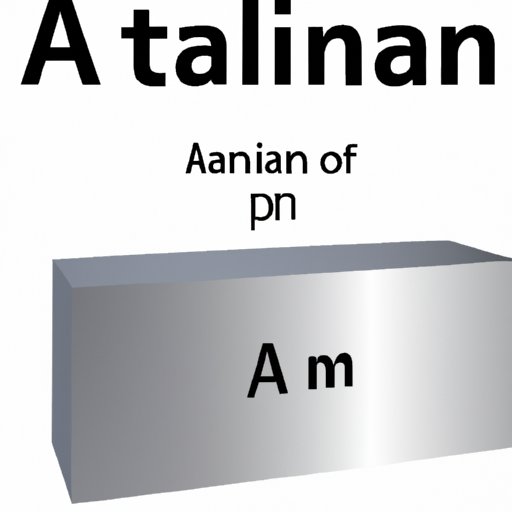Introduction
Valence electrons are the outermost shell electrons of an atom and play a crucial role in determining the chemical properties of that element. In this article, we will be exploring the properties of valence electrons in aluminum, their impact on its chemistry, and their significance in everyday life.
Exploring the Properties of Aluminum’s Valence Electrons
Aluminum is a chemical element with atomic number 13, which means it has 13 protons and 13 electrons. The number of valence electrons in aluminum is 3, as there are three electrons in the outermost shell. This electron configuration gives aluminum a notably high reactivity.
The electron configuration of aluminum is 1s22s22p63s23p1. This means that the three valence electrons are located in the third shell, which is also known as the valence shell. The valence shell is the most reactive part of an atom as it has the highest energy level.
A Look at How Aluminum’s Valence Electrons Impact Its Chemistry
Aluminum’s three valence electrons are responsible for its chemical properties, such as reactivity, bonding, and oxidation states. As the valence shell is the most reactive part of an atom, aluminum is highly reactive, meaning it can easily form bonds with other elements or compounds. This makes aluminum useful for a variety of applications, from creating alloys to forming compounds.
Aluminum’s valence electrons also determine its oxidation states, or the number of electrons it can give or receive during a reaction. Aluminum typically has an oxidation state of +3, meaning it can give away three electrons during a reaction. This oxidation state makes aluminum very reactive, as it is always looking to form more stable bonds by giving away its extra electrons.
Examining the Role of Aluminum’s Valence Electrons in Bonding
One of the most important roles played by aluminum’s valence electrons is in bonding. Depending on the type of bond formed, aluminum’s valence electrons can be used to create ionic, covalent, or metallic bonds.
Ionic bonds are formed when one atom transfers electrons to another atom. In this case, aluminum’s three valence electrons can be transferred to another atom, creating an ionic bond. Covalent bonds, on the other hand, involve two atoms sharing electrons. Aluminum can share its three valence electrons with another atom to create a covalent bond.
Lastly, metallic bonds are formed when atoms share their valence electrons with each other. Aluminum’s three valence electrons can be shared between multiple atoms, creating a strong metallic bond.
The Benefits of Aluminum’s Valence Electrons
The properties of aluminum’s valence electrons are what make it so useful in everyday life. Aluminum’s high reactivity makes it ideal for creating strong alloys, while its three valence electrons provide it with a high strength-to-weight ratio. Furthermore, aluminum is highly corrosion-resistant due to its oxidation state of +3, allowing it to withstand harsh environments.
Aluminum also has excellent electrical conductivity thanks to its three valence electrons. The electrons are able to move freely through the metal, making it an ideal material for conducting electricity. This makes aluminum a great choice for wiring and other electrical components.
Analyzing the Interaction of Aluminum’s Valence Electrons with Other Elements
In addition to its properties, aluminum’s valence electrons also have an impact on its interaction with other elements. One of the most important factors to consider is electronegativity, which is the ability of an atom to attract electrons. Aluminum has a low electronegativity, which means it does not attract electrons very well.
Aluminum also has a high polarizability, which is the ability of an atom to be polarized by an external electric field. This means that aluminum’s valence electrons can be easily shifted by an external electric field, making it useful for certain applications.
Finally, aluminum has a relatively low electron affinity, which is the tendency of an atom to accept electrons. This makes aluminum less likely to form strong bonds with other elements, but it also means that it is less reactive than some other metals.
Investigating the Significance of Aluminum’s Valence Electrons in Everyday Life
Aluminum’s valence electrons have a wide range of applications in everyday life. In the automotive industry, aluminum’s light weight and strength-to-weight ratio make it ideal for car parts, while its corrosion resistance makes it a great choice for exterior components. Aluminum is also widely used in the aerospace industry, where its strength and low weight make it perfect for aircraft components.
Aluminum’s valence electrons are also essential in the construction industry. Its corrosion resistance and strength make it a great choice for building materials, while its electrical conductivity makes it ideal for wiring and other electrical components. Aluminum is even used for decorative purposes due to its attractive appearance.
Conclusion
Valence electrons are the outermost shell electrons of an atom and play a crucial role in determining its chemical properties. When it comes to aluminum, its three valence electrons are responsible for its reactivity, high strength-to-weight ratio, and corrosion resistance. These properties make aluminum a popular choice for a variety of applications in the automotive, aerospace, and construction industries.

